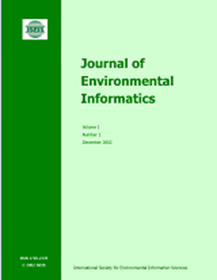Real-Time LNG Buses Emissions Prediction Based on a Temporal Fusion Trans-Formers Model
IF 5.4
1区 环境科学与生态学
Q1 ENVIRONMENTAL SCIENCES
引用次数: 0
Abstract
Emissions from transportation are one of the key factors preventing the achievement of carbon peaking and carbon neutrality by 2050, with particular attention to emissions from buses. Specifically, few research has been conducted on the exhaust emissions characteristics of liquified natural gas (LNG) buses under different driving scenarios. This study proposed a framework for predicting exhaust emissions of LNG buses based on the portable emission measurement system and GPS collaborative perception data. Firstly, the emission distribution characteristics of CO2, CO, HC, and NOx from LNG buses in real-world driving were analyzed by visualization methods. Then, the real-time exhaust emissions of LNG buses were predicted based on the temporal fusion transformers model for both urban and suburban sections of Zhenjiang City, and the model validity was verified. The current and past 10 s driving states were used for predicting the emission rate of LNG buses. The results showed that the proposed model outperforms other advanced algorithms in real-time exhaust emissions prediction of LNG buses, with an average R2 value higher than 0.94 and an average MAPE reduction of 14.19%. The error assessment revealed that the emission values and average emission rates are higher when driving in the urban section compared to the suburban section. Among the influencing factors, traffic conditions have the most significant impacts on the exhaust emissions of LNG buses, followed by road conditions and driving states, with relative feature importance of 48.9, 34.8, and 16.3%, respectively. Additionally, the current and past 10 s driving states also significantly influenced real-time predictions. This study provides an essential theoretical reference for reducing exhaust emissions for city buses.基于时态融合 Trans-Formers 模型的 LNG 巴士实时排放预测
交通排放是阻碍到 2050 年实现碳峰值和碳中和的关键因素之一,其中公交车的排放尤为引人关注。具体而言,针对液化天然气(LNG)公交车在不同驾驶场景下的尾气排放特性的研究很少。本研究提出了一个基于便携式排放测量系统和 GPS 协同感知数据的 LNG 公交车尾气排放预测框架。首先,通过可视化方法分析了 LNG 公交车在实际行驶中 CO2、CO、HC 和 NOx 的排放分布特征。然后,基于时空融合变换器模型对镇江市市区和郊区路段的 LNG 公交车尾气排放进行了实时预测,并验证了模型的有效性。利用当前和过去 10 秒的行驶状态预测 LNG 公交车的尾气排放率。结果表明,所提出的模型在 LNG 公交车尾气排放实时预测方面优于其他先进算法,平均 R2 值高于 0.94,平均 MAPE 降低了 14.19%。误差评估显示,与郊区路段相比,在市区路段行驶时的排放值和平均排放率更高。在影响因素中,交通状况对 LNG 公交车尾气排放的影响最大,其次是道路状况和驾驶状态,相对特征重要性分别为 48.9%、34.8% 和 16.3%。此外,当前和过去 10 秒的驾驶状态也对实时预测产生了重大影响。这项研究为减少城市公交车尾气排放提供了重要的理论参考。
本文章由计算机程序翻译,如有差异,请以英文原文为准。
求助全文
约1分钟内获得全文
求助全文
来源期刊

Journal of Environmental Informatics
ENVIRONMENTAL SCIENCES-
CiteScore
12.40
自引率
2.90%
发文量
7
审稿时长
24 months
期刊介绍:
Journal of Environmental Informatics (JEI) is an international, peer-reviewed, and interdisciplinary publication designed to foster research innovation and discovery on basic science and information technology for addressing various environmental problems. The journal aims to motivate and enhance the integration of science and technology to help develop sustainable solutions that are consensus-oriented, risk-informed, scientifically-based and cost-effective. JEI serves researchers, educators and practitioners who are interested in theoretical and/or applied aspects of environmental science, regardless of disciplinary boundaries. The topics addressed by the journal include:
- Planning of energy, environmental and ecological management systems
- Simulation, optimization and Environmental decision support
- Environmental geomatics - GIS, RS and other spatial information technologies
- Informatics for environmental chemistry and biochemistry
- Environmental applications of functional materials
- Environmental phenomena at atomic, molecular and macromolecular scales
- Modeling of chemical, biological and environmental processes
- Modeling of biotechnological systems for enhanced pollution mitigation
- Computer graphics and visualization for environmental decision support
- Artificial intelligence and expert systems for environmental applications
- Environmental statistics and risk analysis
- Climate modeling, downscaling, impact assessment, and adaptation planning
- Other areas of environmental systems science and information technology.
 求助内容:
求助内容: 应助结果提醒方式:
应助结果提醒方式:


